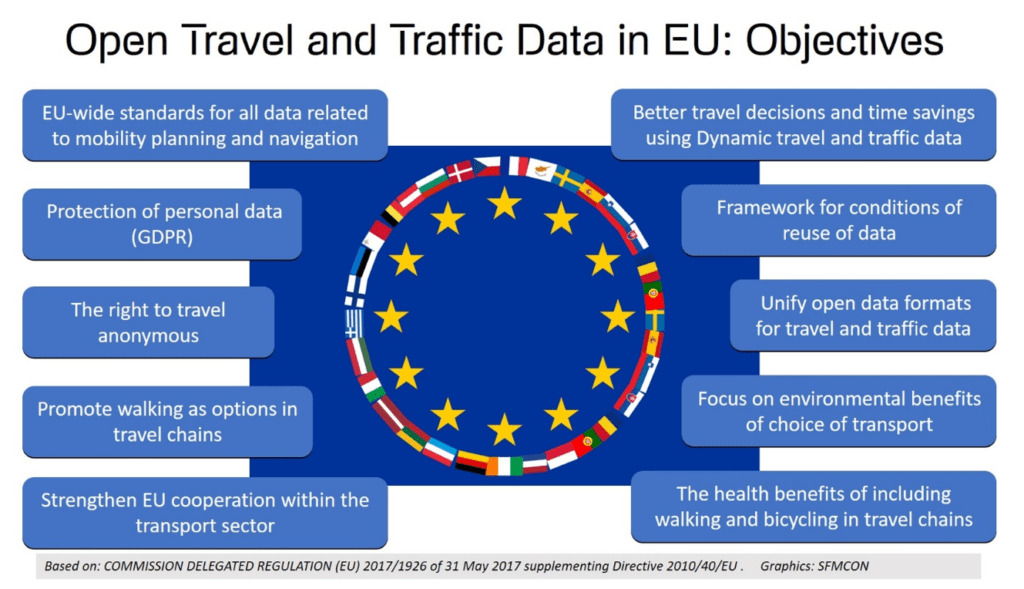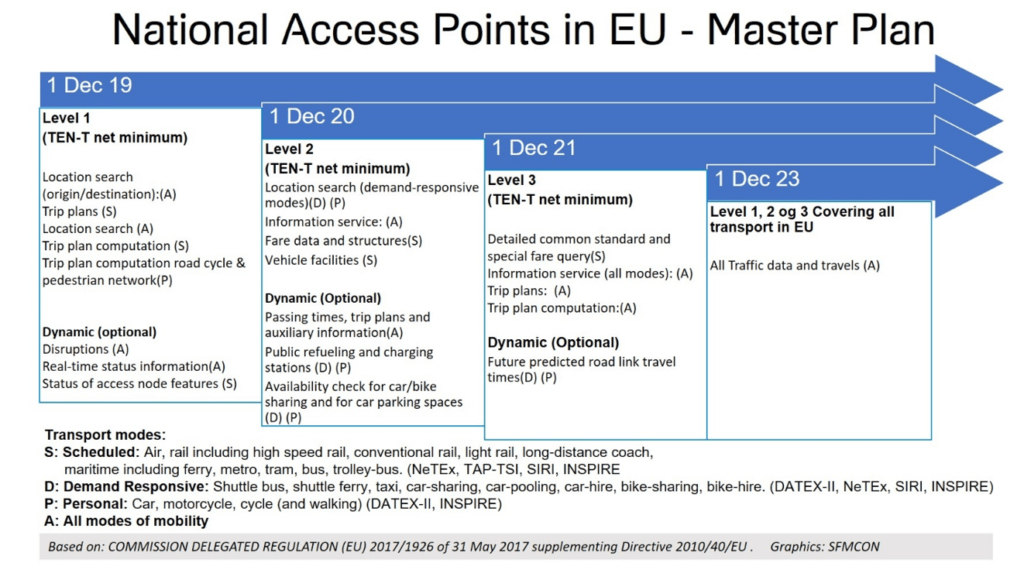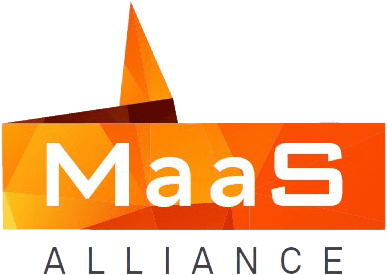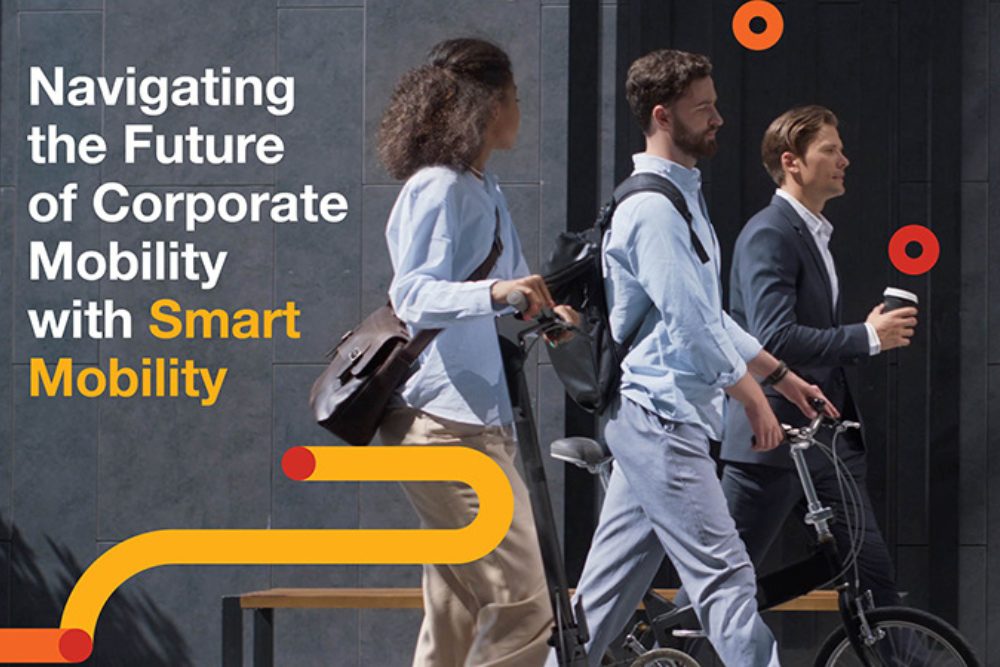With the regulation EU 2017/1926 of 31 May 2017, on the provision of EU-wide multimodal travel information services (short: MMTIS NAP) EU continues to fill out the framework for the deployment of intelligent transport systems. The regulation calls for standardization of formats for all traffic and travel data from all public and private modalities and the creation of a National Access Point (NAP) in all EU Member States to be the point where (professional) users of mobility data can get to know where to find data from all mobility actors in each country. So, what does this mean for MaaS?
The goal of the regulation is very “MaaSive”: it aims at improving awareness of alternatives to the use of private owned cars for mobility and increased use of ground transport as an alternative to short and medium airline routes even across borders. The purpose of national access points (NAPs), as introduced in the regulation, is to create a catalogue for open data covering all modalities from all transport actors as a basis for creating multimodal travel information services. A national access point is a digital interface providing access to open mobility data either directly or through reference to the data sources. All transport actors are required to as a minimum to make static travel and traffic data available as open data and register their basic data and relevant travel and traffic data at same quality as used internally on the actors own digital platforms.
Probably all of you has heard us begging for better access to static and dynamic transport data. With the abovementioned regulation, the European Commission has done a great job in facilitating the access to the data. Indeed, after the full implementation and enforcement of this regulation EU-wide (by 1 Dec 2023) the only missing component is facilitating the third-party sales of tickets and other mobility services. However, this missing component remains crucial for MaaS – without access to tickets, the one-stop-shop for all mobility options, without multiple redirections to other websites or apps, cannot be realised. Also, advanced pricing models, such as bundling of services and time-based subscriptions, cannot be developed without full ticketing and payment integration.

What is required and by when?
The EU Master Plan describes the phases of rollout of NAPs (see the picture below). On 1 December 2019, all EU countries should have opened a national access point for mobility data and populated it with open data from the scheduled modes of mobility (mostly public transport) following the NeTEx and SIRI standards. Here you can find to up-to-date information on the existing NAPs.

As the next step, by 1 Dec 2020 (in 10 months!) also all demand responsive transport (DRT) modalities in the EU shall publish open mobility data through the National Access Points (NAP). Demand responsive modes defined in the MMTIS regulation includes shuttle bus, shuttle ferry, taxi, car sharing, car-pooling, car hire, bike sharing and bike hire. All this data is available today but in different formats and typically only published through proprietary and closed digital channels. The opening of fare data is mostly a task for regulatory bodies and assumed to be funded and delivered.
The three first milestones at EU Masterplan shall at a minimum apply for the European TEN-T network and for static travel data. Inclusion of dynamic travel and traffic data is optional with a roll out as listed. 1 December 2023 all mobility data in the EU zone shall observe the regulation.
Where are we, and what is missing seen from a MaaS perspective?
The introduction of the aforementioned regulation and NAPs has been an important tool from European Commission giving push for development of new mobility services, and information and MaaS platforms. The MMTIS regulation simplifies the efforts to create Mobility as a service (MaaS) solutions as almost all required primary mobility data are in the same open formats. Living up to EU regulation is mandatory, however it seems the MMTIS regulation is not yet widely known in the industry. The complexity of complying with the MMTIS regulation is not trivial, and of somewhat same magnitude as the GDPR compliance exercise.
After the full implementation of this regulation, the only outstanding element to be opened and standardised is booking and payment. The European-wide regulation would be a great help in standardising and facilitating the third-party sales of tickets and other mobility services and enabling acting on behalf when reselling the transport tickets. These are all crucial for fast roll-out and scalability of MaaS services and would help the industry to unlock the full decarbonisation potential of Mobility as a Service, as anticipated also by the Green Deal of the Commission of Ursula Von der Leyen.
Søren Sørensen, SFMCON ApS, Msc.E.E. System Construction, is an experienced independent management consultant targeting Mobility as a Service and Smart Ticketing programs internationally. Moreover, he acts as an ambassador promoting the conversion from private car mobility to shared mobility and MaaS. He has since 1984 served through executive positions in companies working on large scale programs and change management in the public transport smart ticketing, credit card, video game and airlines communication businesses. Recently Søren Sørensen headed the national travelcard (rejsekort) program at DSB (Danish Railways) and Midttrafik (second largest public transport administrator in Denmark).
Piia Karjalainen is working as Secretary General of the MaaS Alliance in Brussels, Belgium. The MaaS Alliance is an international public-private-partnership, established in 2015, bringing together 96 member organisations worldwide, supporting the development of Mobility as a Service ecosystem, based on the principles of openness, inclusivity, sustainability and user-centricity. She is leading and coordinating all the activities of this international Mobility as a Service community. Previously she has been working in various positions at the European Parliament and the Finnish Ministry of Transport & Communications, mainly dealing with transport strategies, ITS, Mobility as a Service, policy making and EU regulation. She holds a Master of Science in Economics.



